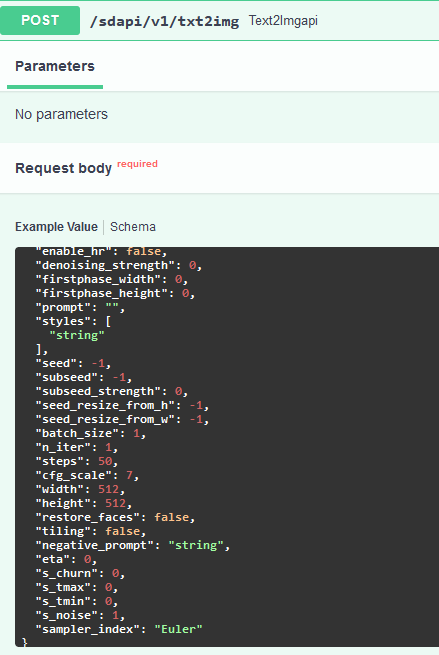-
Notifications
You must be signed in to change notification settings - Fork 26.6k
API
API guide by @Kilvoctu
- First, of course, is to run web ui with
--apicommandline argument - This enables the api which can be reviewed at http://127.0.0.1:7860/docs (or whever the URL is + /docs)
The basic ones I'm interested in are these two. Let's just focus only on
/sdapi/v1/txt2img

- When you expand that tab, it gives an example of a payload to send to the API. I used this often as reference.

- So that's the backend. The API basically says what's available, what it's asking for, and where to send it. Now moving onto the frontend, I'll start with constructing a payload with the values I want. An example can be:
payload = {
"prompt": "maltese puppy",
"steps": 5
}
I can put in as few or as many values as I want in the payload. The API will use the defaults for anything I don't set.
- After that, I dump the json, whatever that means, then I can send it to the API
payload_json = json.dumps(payload)
response = requests.post(url=f'http://127.0.0.1:7860/sdapi/v1/txt2img', data=payload_json).json()
Again, this URL needs to match the web ui's URL. If we execute this code, the web ui will generate an image based on the payload. That's great, but then what? There is no image anywhere...
- After the backend does its thing, the API sends the response back in a variable that was assigned above:
response. The response contains three entries; "images", "parameters", and "info", and I have to find some way to get the information from these entries. - "images" is the generated image, which is what I want mostly. There's no link or anything; it's a giant string of random characters, apparently we have to decode it. This is how I do it:
for i in response['images']:
image = Image.open(io.BytesIO(base64.b64decode(i)))
- With that, we have an image in the
imagevariable that we can work with, for example saving it withimage.save('output.png'). -"parameters" shows what was sent to the API, which could be useful, but what I want in this case is "info". I use it to insert metadata into the image, so I can drop it into web ui PNG Info. For that I simply reference it withresponse['info']
A sample code that should work can look like this:
import json
import requests
import io
import base64
from PIL import Image, PngImagePlugin
url = "http://127.0.0.1:7860"
payload = {
"prompt": "puppy dog",
"steps": 5
}
payload_json = json.dumps(payload)
response = requests.post(url=f'{url}/sdapi/v1/txt2img', data=payload_json).json()
for i in response['images']:
image = Image.open(io.BytesIO(base64.b64decode(i)))
pnginfo = PngImagePlugin.PngInfo()
pnginfo.add_text("parameters", str(response['info']))
image.save('output.png', pnginfo=pnginfo)
- Import the things I need
- define the url and the payload to send
- send said payload to said url through the API
- when we get the response, grab "images" and decode it
- define a plugin to add png info, then add "info" into it
- at the end here, save the image with the png info
For a more complete implementation of a frontend, my Discord bot is here if anyone wants to look at it as an example. Most of the action happens in stablecog.py. There are many comments explaining what each code does. Also a reference can be https://github.com/Kilvoctu/aiyabot/pull/11, my PR where I added API support.
This guide can be found in discussions page.
This is the Stable Diffusion web UI wiki. Wiki Home
Setup
- Install and run on NVidia GPUs
- Install and run on AMD GPUs
- Install and run on Apple Silicon
- Install and run on Intel Silicon (external wiki page)
- Install and run via container (i.e. Docker)
- Run via online services
Reproducing images / troubleshooting
Usage
- Features
- Command Line Arguments and Settings
- Optimizations
- Custom Filename Name and Subdirectory
- Change model folder location e.g. external disk
- User Interface Customizations
- Guides and Tutorials
Developers